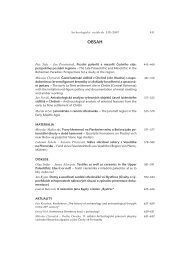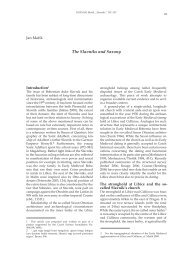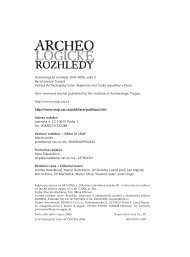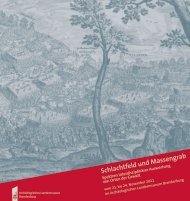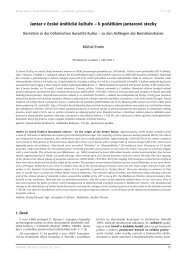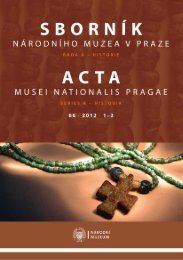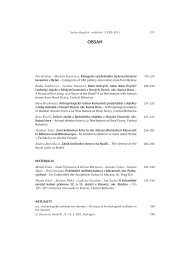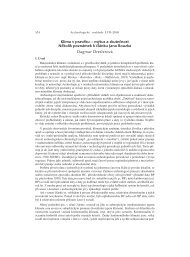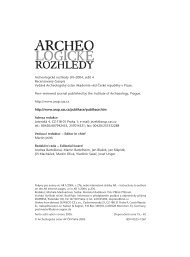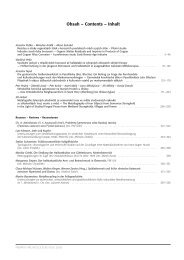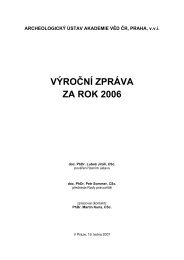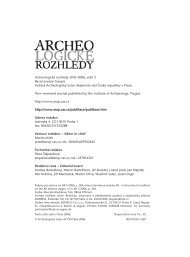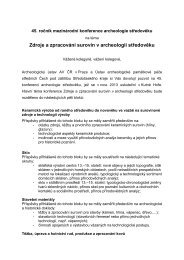Archeologické rozhledy 2009 - Archeologický ústav AV ČR
Archeologické rozhledy 2009 - Archeologický ústav AV ČR
Archeologické rozhledy 2009 - Archeologický ústav AV ČR
You also want an ePaper? Increase the reach of your titles
YUMPU automatically turns print PDFs into web optimized ePapers that Google loves.
<strong>Archeologické</strong> <strong>rozhledy</strong> LXI–<strong>2009</strong> 137Líbal, D. 2001: Katalog gotické architektury v České republice do husitských válek. Praha.Líbal, D. – Muk, J. 1996: Staré Město pražské. Architektonický a urbanistický vývoj. Praha.Lněničková, J. 2002: Sklo v Praze. Praha.Mendl, B. 1932a: Z hospodářských dějin středověké Prahy. In: Sborník příspěvků k dějinám hlavního městaPrahy V, Praha, 161–390.— 1932b: „Vici Theutunicorum“ a „civitas circa s. Gallum“. Český časopis historický 38, 237–259.Nováček, K. 2000: Výroba a zpracování kovů na sídlišti u sv. Petra na Poříčí v Praze. Archaeologica Pragensia15, 219–230, 233–241.Pražák, J. 1993: Privilegium pervetustum Boleslai. In: Milénium břevnovského kláštera (993–1993). Sborníkstatí o jeho významu a postavení v českých dějinách, Praha, 13–24.Profantová, N. – Špaček, L. 1991: Nákončí z doby avarské z Prahy 1 – Nového Města. Archaeologica Pragensia11, 93–101.Razím, V. – Zahradník, P. 2006: Hradební věže v Bartolomějské ulici na Starém Městě pražském. Průzkumypamátek XIII/1, 35–72.RBM: Regesta diplomatica nec non epistolaria Bohemiae et Moraviae. Pars II, III, IV. Ed. J. Emler. Pragae1883, 1890, 1892.Richter, M. 1982: Hradišťko u Davle. Městečko ostrovského kláštera. Praha.Richterová, V. 1977: Záchranný výzkum v Klimentské ulici, Praha 1, Nové Město. <strong>Archeologické</strong> <strong>rozhledy</strong> 29,417–427.Špaček, L. 1978: Prognóza dalšího výzkumu Petrské čtvrti (osada u sv. Petra na Poříčí). Archaeologia historica3, 387–391.— 1984: Výzkum v Petrské ulici. Příspěvek k datování středověké hmotné kultury. Archaeologica Pragensia5, 71–80.Tomas, J. 1984: Problematika studia dějin Prahy v období raného feudalismu. Vývoj pražské raně feudálníměstské aglomerace. Archaeologica Pragensia 5, 35–56.Tomek, W. W. 1866: Základy starého místopisu Pražského. Oddíl I. Staré Město pražské. Praha.— 1870: Základy starého místopisu Pražského. Oddíl II. Nové Město pražské. Praha.Urban, J. 1991: Dějiny Biskupského dvora na Novém Městě pražském. Pražský sborník historický XXIII,28–49.Vařeka, P. – Bureš, M. 1997: Hmotná kultura sídlištního komplexu u sv. Petra na Poříčí ve vrcholném a pozdnímstředověku – výzkum v letech 1988–1990. Archaeologica Pragensia 13, 145–156.On the pre-history of two Towns of PragueThe article presents the results of the archaeological excavation of a lot in Soukenická Street No. 21(1998–2000) in the northern part of Prague’s New Town (fig. 1: 1), near the former RomanesqueChurch of St. Clement (fig. 1: 2). The oldest evidence of the use of the studied land in medieval timesare the relics of countersunk building (feature 5: fig. 2, 3) and, especially, the contents of its fill.The rectangular floor plan of this approximately 7 x 8.7 m feature with a wooden pillar structure isreduced in size by a block of earth left in the northeast corner, which is evidence of the internal segmentationof the space of the building. The relics do not show any indication of additional layoutmodifications. The period of functional use of the building is pinpointed by a pot from the 12 th orthe early 13 th century embedded upside down in the floor (fig. 4: 1). A sacrificial offering in the formof a chicken skeleton (without its left leg) was preserved beneath the pot. The feature fill layers(fig. 3) and their contents, which belong to the same timeframe, testify to deliberate filling beforethe mid-13 th century, after the wooden support elements of the building had been removed. Anothercountersunk feature with a flat base was documented in a section 2.1 to 3.2 m in length (north walldestroyed) beneath the façade of the front wing (feature 9: fig. 2 right above); part of a pot and a lamp(fig. 6: 1, 2) from the lowest layer of its fill belong to the 13 th century.In addition to similar archaeological material from the fill, relics of a secular building found inthe rectangular countersunk features and documented on the large area of the northern part of today’s



